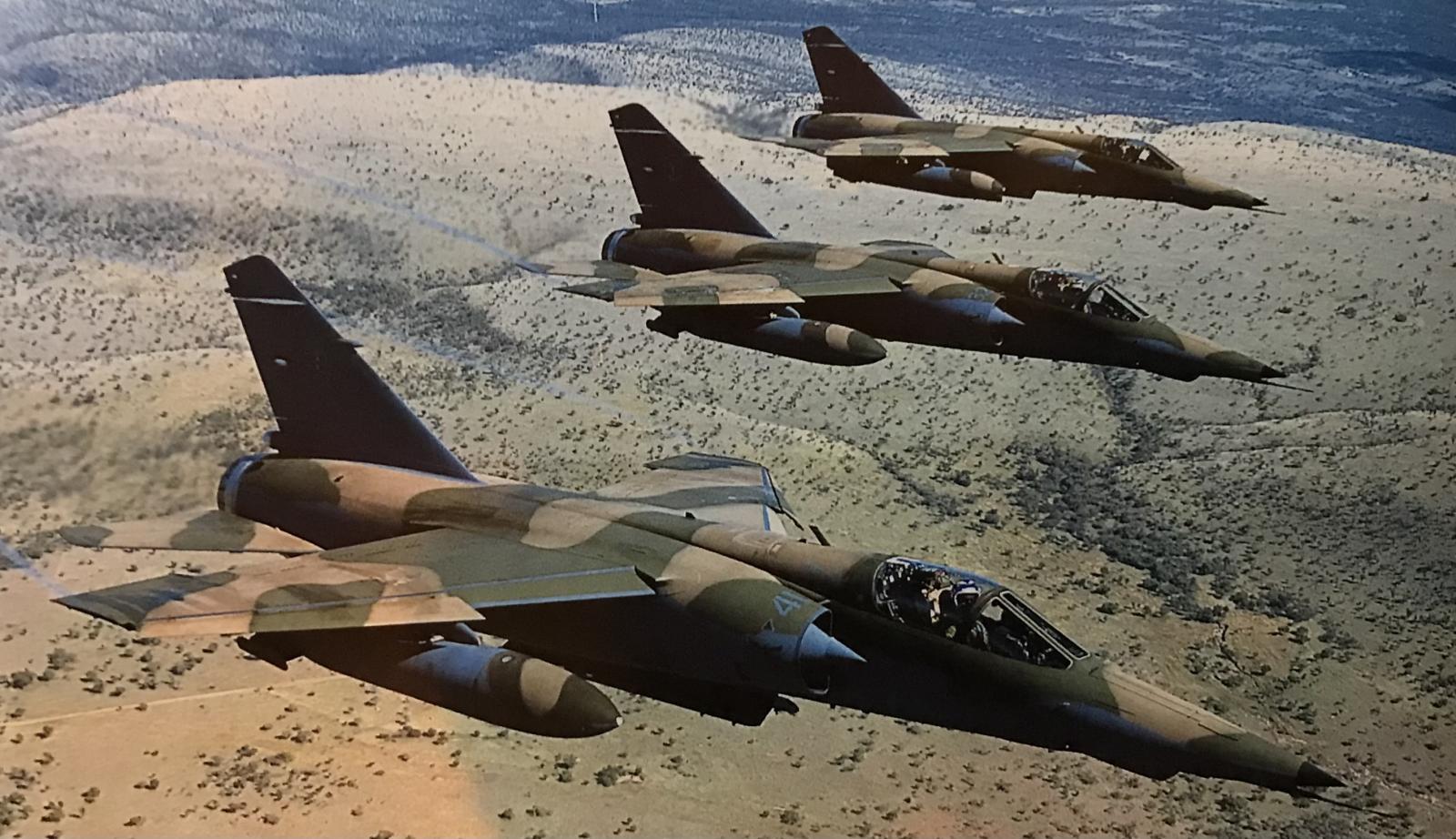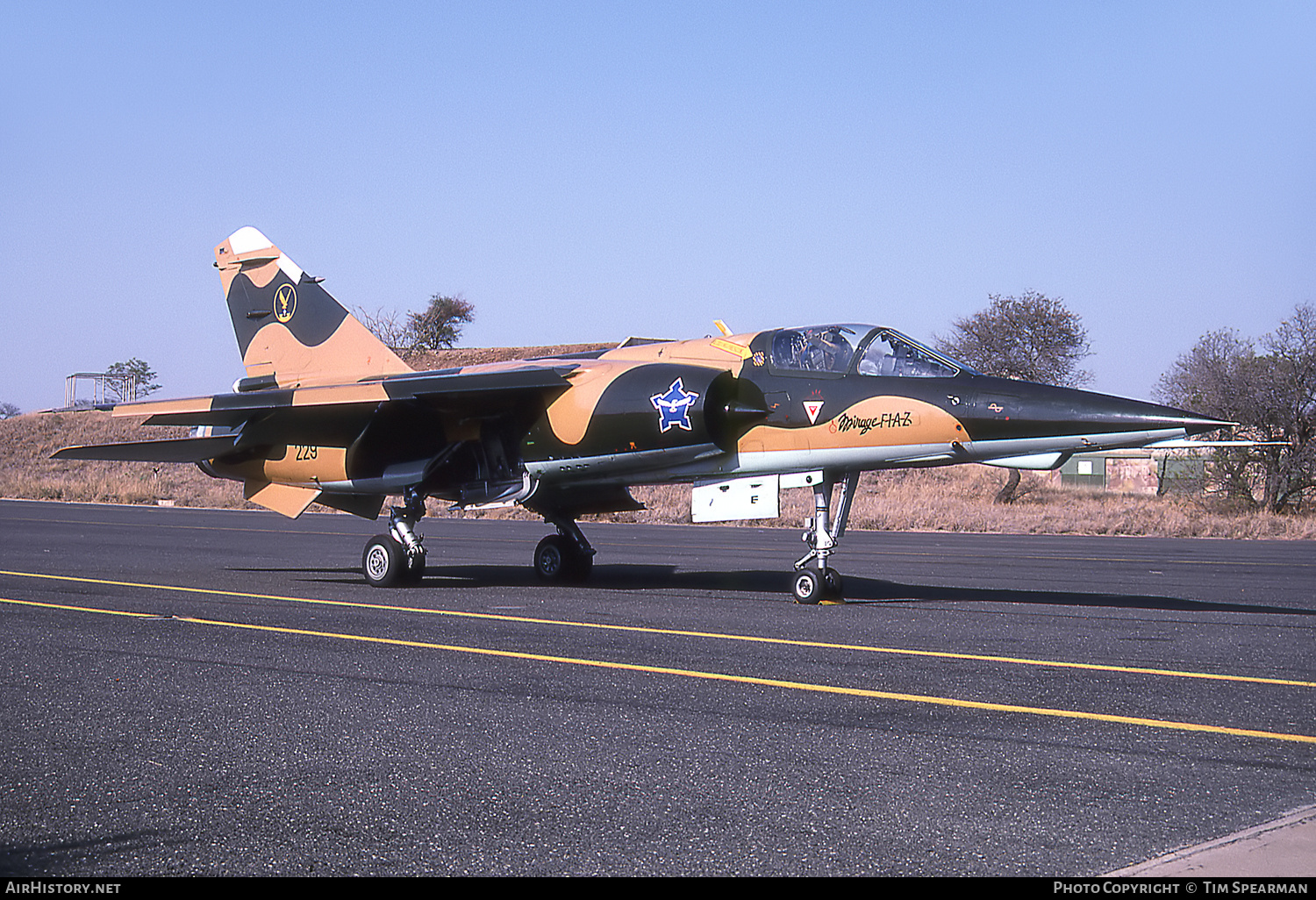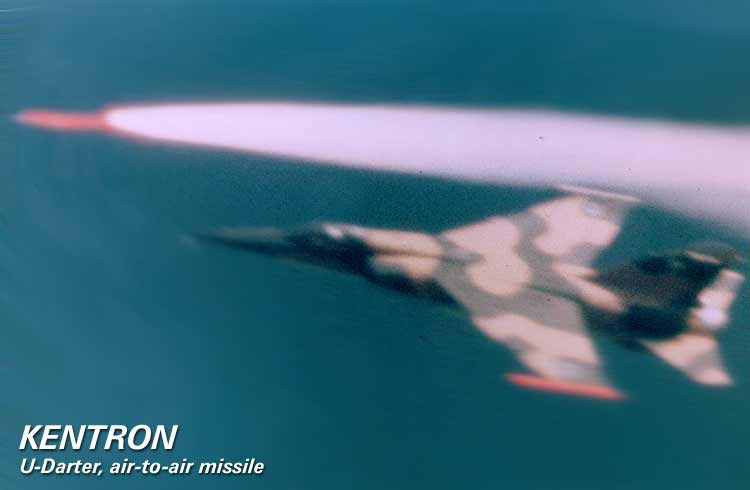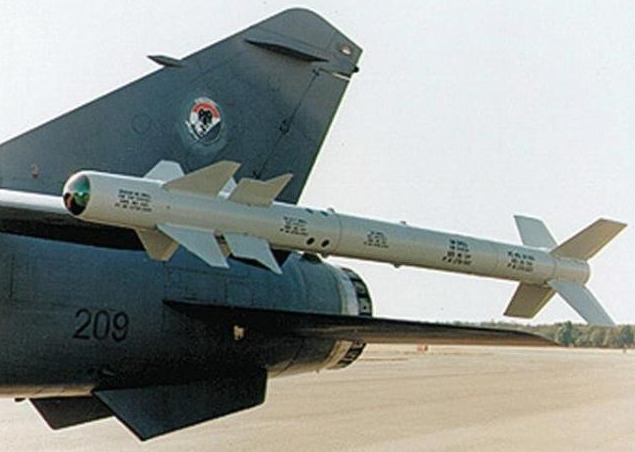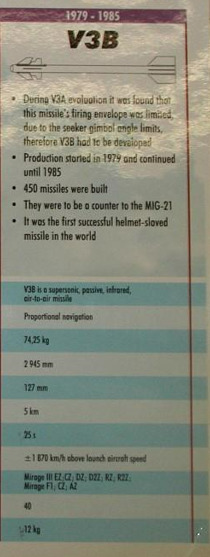- Yes, as a tech tree vehicle
- Yes, as a premium vehicle
- Yes, as an event vehicle
- Yes, as a squadron vehicle
- No, I would not like to see the Mirage F1AZ in game.
This is one of several Mirage F1s retained by the Paramount group which they currently maintain for aggressor duties in mock combat against USAF fighter squadrons. They also provide support services for the current existing civilian and military operators of the Mirage F1 in general. South Africa operated F1s for over twenty years.
Introduction
The Dassault Mirage F1 is a 50 year old classic at this point which is still in operation with five of the world’s air forces. Of these, several owe their existence - initial and continued - to what may seem to be an unlikely benefactor. Indeed, the Mirage F1A specifically, which is in use with Gabon, Libya and the Republic of the Congo as of today, would not have been made were it not for South Africa’s request to Dassault for a specialized ground attack version of the platform. That is how the Mirage F1AZ was born. While the air force’s downscaling led to what might have been a slightly early retirement for the type, the Mirage F1AZ served well for twenty years in hostile environments. Between the F1AZ and F1CZ the Mirage F1 earned its place as beloved by South African pilots and enthusiasts alike and stands proudly in the company of South Africa’s other Mirage variants as an effective combat aircraft.
TL;DR
- Ground attack derivative of the familiar supersonic third-generation fighter
- Airborne interception radar replaced with a smaller ranging radar allowing for additional fuel
- Digital radar warning receiver and healthy countermeasures capacity for defense against missiles
- Up to four agile all-aspect IR-guided air-to-air missiles with HMCS
- Mostly unguided munitions with ballistic computing capability for ground attack
- Raptor glide bomb gives precision strike capability but with only one bomb/run
Why it should be in the game: While South Africa’s ground subtree is replete with vehicles, currently there is only one SAAF aircraft in game, that being the JAS39C. Most SAAF planes would likely end up in Rank VII where Britain trends towards the lower end in terms of the amount of researchable aircraft. Adding the Mirage F1AZ would give SAAF enthusiasts more representation for their subtree while also complementing the existing roster of British planes in interesting ways. Case in point: despite being a dedicated ground attack aircraft the Mirage F1AZ will most likely find its niche in air battles as a deadly opponent in short-range combat with its powerful V3C and V3S missiles coupled with a helmet mounted cueing system. This would make for a refreshing change of pace compared to the Phantoms which generally rely on their radar. It would also be a strong showing for the SAAF subtree - the Mirage F1AZ is a wholly unique variant of the Mirage F1 platform. Compared to other potential additions like the Mirage F1CZ or Mirage IIIEZ, I personally believe the Mirage F1AZ would be more exciting as while the latter two are interesting in their own ways they are not radically different from the existing variants in the French tech tree.
History
Besides the radome and anti-glare finish in front of the cockpit this Mirage F1A, which would later be known as ‘216’ in SAAF service, has bare metal skin. It is being exhibited at the Paris Airshow in hopes to secure more export bids than just South Africa; besides them, only Libya would purchase F1As directly from Dassault. Based on what is known about the time frame of the plane’s development this is probably the 1975 air show. ‘216’ was the primary development aircraft in France and later in South Africa.
Towards the end of 1966, a prototype Dassault aircraft would take to the air for the first time. It was an interesting departure from the delta-wing design of the Mirage III which was beginning to become popular at the time. Instead the new plane had a high-mounted swept wing and a conventional tail. As we know now, this was the Mirage F1 prototype. The plane had a similar overall footprint to the Mirage III but could carry far heavier payloads and more fuel thus making it a quite capable multirole fighter. After four prototypes had been produced Dassault would secure its first customer: the Armee de l’air (French Air Force). Paul Dubois states that the second operator to get their hands on the plane would be the South African Air Force. While a few air forces would take deliveries in 1975 (including the SAAF), Zach Repsold would reportedly be the first South African to fly a Mirage F1 all the way back on October 6, 1971. The reason the SAAF were shopping around for a new fighter when they had first acquired the Mirage III within the decade of first testing the Mirage F1 is unclear but based on operational usage it was most likely a desire for better air support capability. The Mirage IIICZ was used more than the Mirage IIIEZ in the Border War despite the latter having better payloads and this is most likely because the Mirage F1 in turn had better payloads than the Mirage IIIE. The Mirage F1 also had a better takeoff and landing run, more loiter time and supposedly improved maneuverability (although at the time of writing in War Thunder this is only true compared to the Mirage IIIE and even then it has significantly worse instantaneous pull.)
Regardless the SAAF immediately recognized that the new fighter had a lot of potential and reportedly got a license to produce them with a planned total of 100 units. The 1977 U.N. arms embargo against South Africa stifled this plan but Atlas Aircraft Corporation had acquired everything necessary to assemble Mirage F1s by that point. A total of sixteen Mirage F1CZ interceptors would be delivered to the SAAF, providing improved interception capability. However a much larger order, both in the number of aircraft procured and overall cost, was placed around the same time, and this one was quite interesting.
This photo shows the Mirage F1A development aircraft (with a camera under its nose) testing the unique 14 bomb loadout of the F1A. The quadruple bomb rack on the inboard wing pylon was rather thick in order to serve as an additional fuel tank. In the hot and high conditions of South Africa getting a plane with 14 x 500 lb Mk 82 bombs would be hard enough; 14 x 400 kg French G.P. bombs was probably out of the question. (Photo from P. Dubois collection)
The Mirage F1A was specifically made for a South African requirement for a ground-attack optimized version of the Mirage F1 and was mainly funded by the South African government. In concept it would be similar to the Mirage 5 in the sense that the impressive air interception abilities of the Mirage F1C would be completely removed in favor of increasing range. Therefore the Cyrano IV radar, which was unnecessary for air support missions, was replaced with the significantly smaller AIDA 2 range-only unit. This had an air-to-air ranging mode but was generally there for air-to-ground. To supplement it in this role the F1A had a laser rangefinder unit in a fairing underneath the nose. Aircraft avionics could now be moved to the empty space in the nose which allowed for an additional fuel tank to be positioned behind the cockpit. Even on the best of days the Mirage F1 did not have much range without its drop tanks, so for maximum payload over distance a retractable refueling probe was installed as well. It was made retractable mostly for secrecy reasons though as a bonus it probably offered the slightest bit of drag reduction. In addition combined bomb rack/fuel tanks were developed specifically for the aircraft and an antenna was installed allowing for the operation of one centerline AS-30 missile. To get this payload to its target the F1A could rely on an advanced moving map display along with a doppler navigational radar beneath the cockpit.
Pop quiz time! Which of these are Mirage F1AZs and which are Mirage F1CZs? Regardless they are all in delivery camouflage schemes with the RSA colors on the rudder (shown for historical purposes only). As time went on the plane’s colors overall would become more muted and the garish rudder livery would disappear as the operating environment over Angola became more and more treacherous.
The first Mirage F1AZs arrived in South Africa for assembly in March 1976. The original development schedule was accelerated due to the impending arms embargo so not all of the new systems could finish testing in France. Therefore the F1AZs would have some teething issues, but the SAAF probably figured having a plane with some growing pains was better than not having the plane at all. The acquisition of the Mirage F1 in general was originally not well publicized but especially in the case of the F1AZ. Despite its first sortie taking place on July 6, 1978 the mere existence of the ground attack variant was not public information until 1980. Oddly enough (and most likely coincidentally) 1980 was not a particularly good year for the F1AZ. The steady supply of Soviet equipment into Angola was not just limited to MiG aircraft but short and long-range SAMs including their powerful search radars. S-125 missile systems reportedly hit two Mirages, ‘234’ and ‘237’, but considering that the aircraft was limped back to base the missile must have detonated far away. Either way it was obvious that the skies were only going to get more dangerous and the existing radar warning system on the F1AZ was not going to cut it.
There’s no kill like overkill for this Mirage F1AZ: two ELT-555 active jamming units are carried, one under each wing, with a large chaff/flare pack on “station 0” seen jutting down close to the intakes. This seems to be a relatively similar solution to France’s Mirage F1Cs. Supposedly the Mirage’s pilots disliked the bulky countermeasures packs as it added a large amount of drag. Either way based on available evidence the station 0 fittings were unlikely to have been used in Angola.
One of the most important upgrades came in the form of a new radar warning system first deployed by 1983. The very creatively named Radar Warning System was a quantum leap forward compared to the original Thompson-CSF BF unit of the Mirage F1. Reportedly developed in collaboration with Israel, the RWS was a fully digital system with new spiral antennae which allowed for precise direction identification of incoming radar signals. Additional omnidirectional antennae enhanced the system’s accuracy and ability to classify threats against a digital databank. This system successfully identified S-125s, 9K33s and P-35s during operations over Angola from 1987-1988. For anti-radar countermeasures the F1AZ could carry the ELT-555 jamming pod underwing. Later it would receive chaff/flare dispensers with programmable deployments known as the Radar and Infrared Misleading System (RIMS). Originally the countermeasures fit consisted of large underwing dispensers. Due to their design (or lack thereof) they limited the aircraft’s speed severely towards higher Mach numbers, though this effect would have been less pronounced at lower altitudes. The second attempt was more fruitful - new, thicker ventral fins could contain 30 chaff/flare cartridges each for a total of 60 without noticeable impacts on the plane’s performance. The RIMS modifications do not seem to have been embodied before hostilities over Angola ended. Finally weapons fits were continually revised. Originally the plane would have carried French G.P. bombs; later, 1000 lb British bombs were used before being phased out in favor of 250 lb Mk 81 and 500 lb Mk 82 bombs. For air-to-air missiles the plane would have shipped with Matra R.550 Magics but once the V3B Kukri entered service it would be the standard self-defense armament for the Mirage F1AZ with the R.550s mainly being used on the Mirage F1CZ.
This flight of Mirage F1AZs notably does not have wingtip missiles, which were usually carried quite often. The camouflage scheme is more muted than the delivery paint. The lighting of the picture allows the outline of the panel that covers the retracting fuel probe on the nose of the front aircraft. Further back, the place where the shock cone extension begins is also prominent. The modification enhanced air pressure recovery at higher speeds so it was applied to all SAAF Mirage F1s.
In terms of operational record the Mirage F1AZ was no slouch. Out of the fleet of thirty-two aircraft, only eight were lost and only one of those was to enemy action (‘245’ was shot down by a 9K35 system in 1988 towards the end of hostilities.) The F1AZ was primarily used for its intended purpose of ground attack missions and in this role it was incredibly active, participating in practically every major operation which had air support as a component. It is claimed that in the last seven months of the Border War the F1AZs flew 683 sorties and dropped over 3,000 bombs during those sorties. Due to the plane’s roots as a high speed fighter the F1AZ also had limited success in interception duties. They were more than capable of catching less advanced planes as was the case in 1981 when a Mozambican MiG-17 was intercepted by two Mirages and forced to land at Hoedspruit AFB. However against the feared MiG-23MLs the Mirage F1AZ was unable to enter a proper firing envelope for their V3B missiles and so attacks against the Angolan fighters failed.
The ultimate air-to-air capability of the Mirage F1AZ would be two wingtip V3C Darters and two underwing V3S Snakes (Python 3s). These arrived too late for the Border War and probably would have made the pilots much more confident against Angolan MiGs. The V3C was integrated with the aircraft’s helmet mounted cueing system (note the blocks on each side of the pilot’s helmet) and the V3S most likely was as well.
The Mirage F1AZ spent its years after the cessation of hostilities over Angola primarily in weapons testing. V3C Darter air-to-air missiles underwent a lengthy qualification process and were finally ready after the war was over while V3S missiles from Israel were also integrated. Meanwhile the Raptor I glide bomb, which had successfully been used on the Buccaneer S.50 during the war, was integrated with the Mirage F1AZ. Laser-guided Griffin bombs were also tested and cleared for carriage in the mid-90’s. However, the aircraft could not self-designate targets. One aircraft was also used as a flying test bed for the Atar Plus engine upgrade program which anecdotally was applied to the Cheetah C. The plan was to keep upgrading the Mirages to keep them relevant but this would not come to pass. The aforementioned Cheetah provided a strong air defense and strike platform and while the F1AZ was still a capable aircraft budget rationalization forced the SAAF to shelve them in 1997 after twenty years of service. This opened more avenues for private ventures; aircraft ‘216’ was experimentally re-engined with the Russian SMR-95 as the “Super Mirage F1” while aircraft ‘233’ and ‘235’ were used as an avionics test bed. Aerosud would acquire the twenty-four remaining Mirages for use as test beds and marketing to other countries, securing sales to Gabon and the Republic of the Congo. South African expertise with the Mirage F1 allowed Paramount to continue providing maintenance services for operators into the present day and South Africa still offers various upgrades for the Mirage F1 to this day such as integration of the Raptor II glide bomb.
Mirage F1AZ ‘233’ and ‘235’ are known to have incorporated a rearview Missile Approach Warning System, necessitating a fairing to be installed between the ventral fins. Both aircraft seem to have been used as avionics testbeds by Aerosud. The MAWS was installed for testing prior to adoption by the Cheetah and may have reached the whole Mirage fleet had they not been retired. (Photo from Garth Calitz)
Specifications
Dassault-Breguet Mirage F1AZ
Dimensions:
- Length: 15.25 m (50 ft 0 in)
- Span: 8.44 m (27 ft 8 in)
- Height: 4.49 m (14 ft 9 in)
Weight:
- 7,824 kg (17,249 lb) empty
- 11,540 kg (25,441 lb) gross
- 17,200 kg (37,920 lb) maximum takeoff weight
Propulsion: 1 x SNECMA Atar 9K50 turbojet engine
- Game stats as installed in the Mirage F1C:
- 4,860 kgf (10,714 lb) static thrust
- 5,882 kgf (12,968 lb) thrust at 1,200 km/h (746 mph)
- 6,760 kgf (14,903 lb) static thrust with afterburner
- 9,817 kgf (20,254 lb) thrust with afterburner at 1,200 km/h (746 mph)
Maximum speed:
- 1,297 km/h (806 mph) at sea level
- 2,593 km/h (1,611 mph) at 10,973 m (36,000 ft)
Service ceiling: 15,240 m (50,000 ft)
Armament:
- Guns:
- 2 x DEFA 553 30 mm autocannon (150 rounds each; 300 total)
- Air-to-air missiles:
- Up to 2 x V3B Kukri IR-homing air-to-air missile
- Up to 2 x V3C Darter IR-homing air-to-air missile
- Up to 2 x V3S Snake IR-homing air-to-air missile
- Bombs:
- Up to 14 x Mk 81 250 lb G.P. bomb
- Up to 14 x Mk 82 500 lb G.P. bomb
- Up to 14 x SAMP 400 kg G.P. bomb
- Up to 6 x British 1,000 lb G.P. bomb (more perhaps possible, six is the most observed)
- Up to 4 x Mk 20 Rockeye 500 lb cluster bomb
- Guided bombs:
- Up to 1 x Raptor I glide bomb (requires datalink pod)
- Rockets:
- Up to 72 x SNEB 68 mm rocket
- Air-to-ground missiles:
- Up to 1 x AS-30 missile
- Drop tanks:
- Up to 3 x RP35 1,200 liter (317 gal) drop tanks
Crew: 1
Additional equipment:
- AIDA 2 ranging radar
- Laser rangefinding/attack system
- Ballistic computer: CCIP/RP (Guns, rockets and bombs)
- Digital Radar Warning System
- ELT-555 jamming pod
- Countermeasures dispensers:
- 6 x 10 round countermeausres dispenser, three in each ventral fin (60 total)
- 16 x 10 round countermeasures dispenser, eight in each spigot fairing (160 total)
- Moving map display
- Doppler navigational radar
- Sight HUD
- HMCS
- Ejection seat
- Radio altimeter
- IFR probe
- Airbrakes
Gallery
Sources
- Flight Manual - Aircraft Operating Instructions - Mirage F1AZ Aircraft (rev. June 13, 1990)
- The Dassault Mirage F1 in South African Air Force service by Malcom Reid (2024)
- Mirage F1 in SAAF Service by Paul Dubois
- Mirage F1: origins, characteristics and performance data
- Jane’s Avionics 1987-88
- The SAAF Forum • View topic - Mirage F1 Miscellanea
- http://admin.denel.co.za/uploads/3231e428ad2deb55d4a3759e3585adf2.pdf
- The South African Air Force
- December / January 2020 by Flyer & Aviation Publications - Issuu
- Dassault Mirage F1 - Wikipedia




